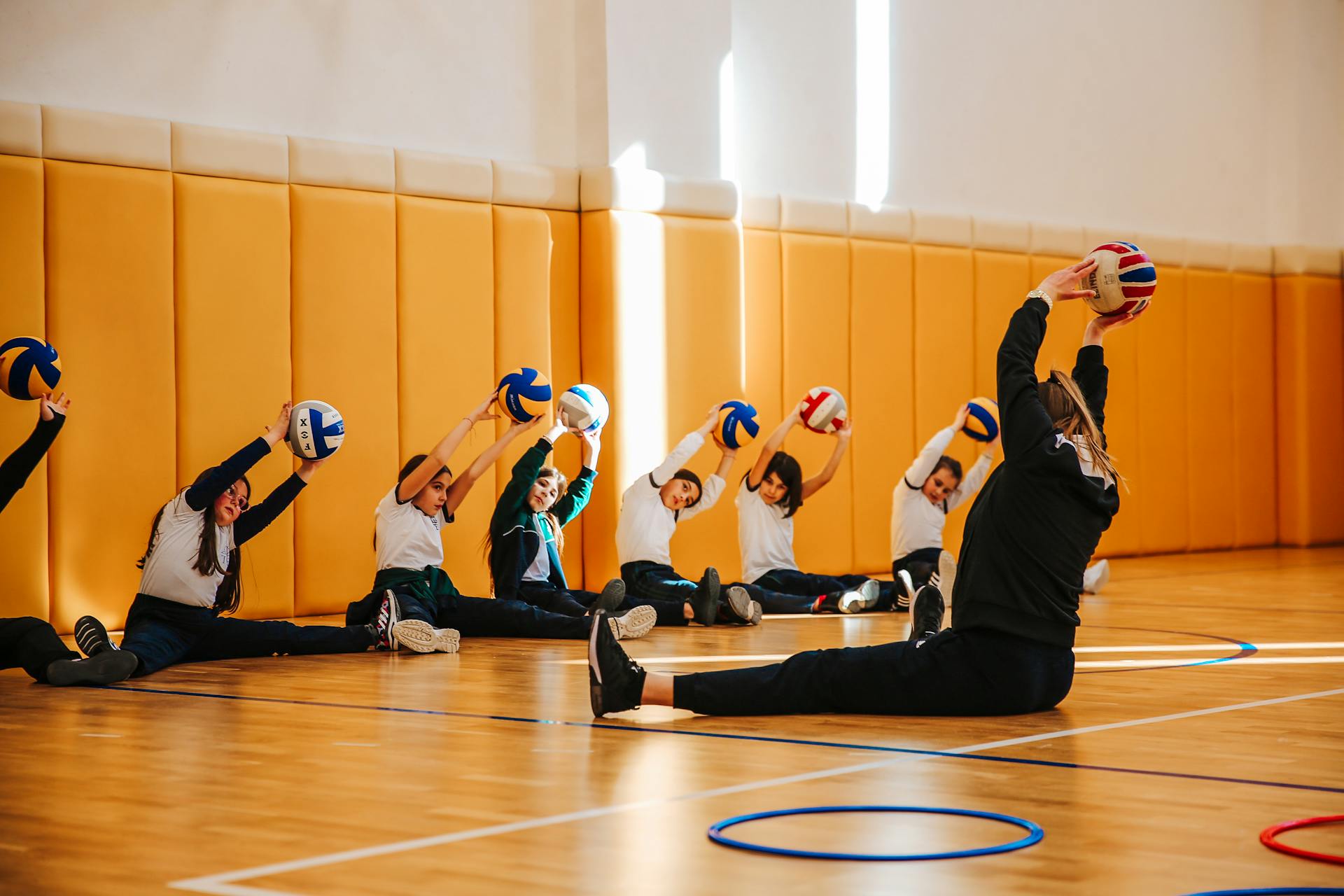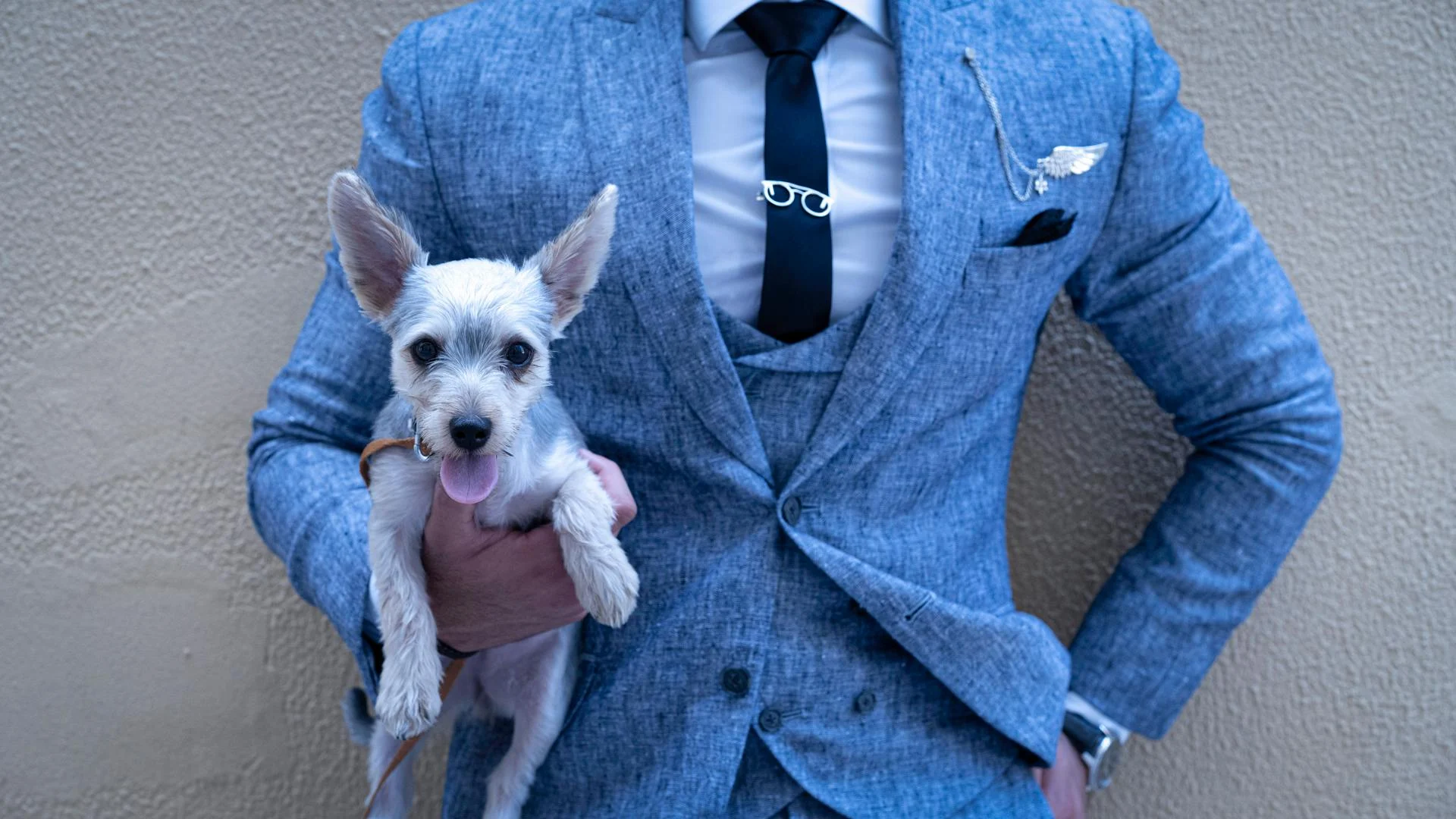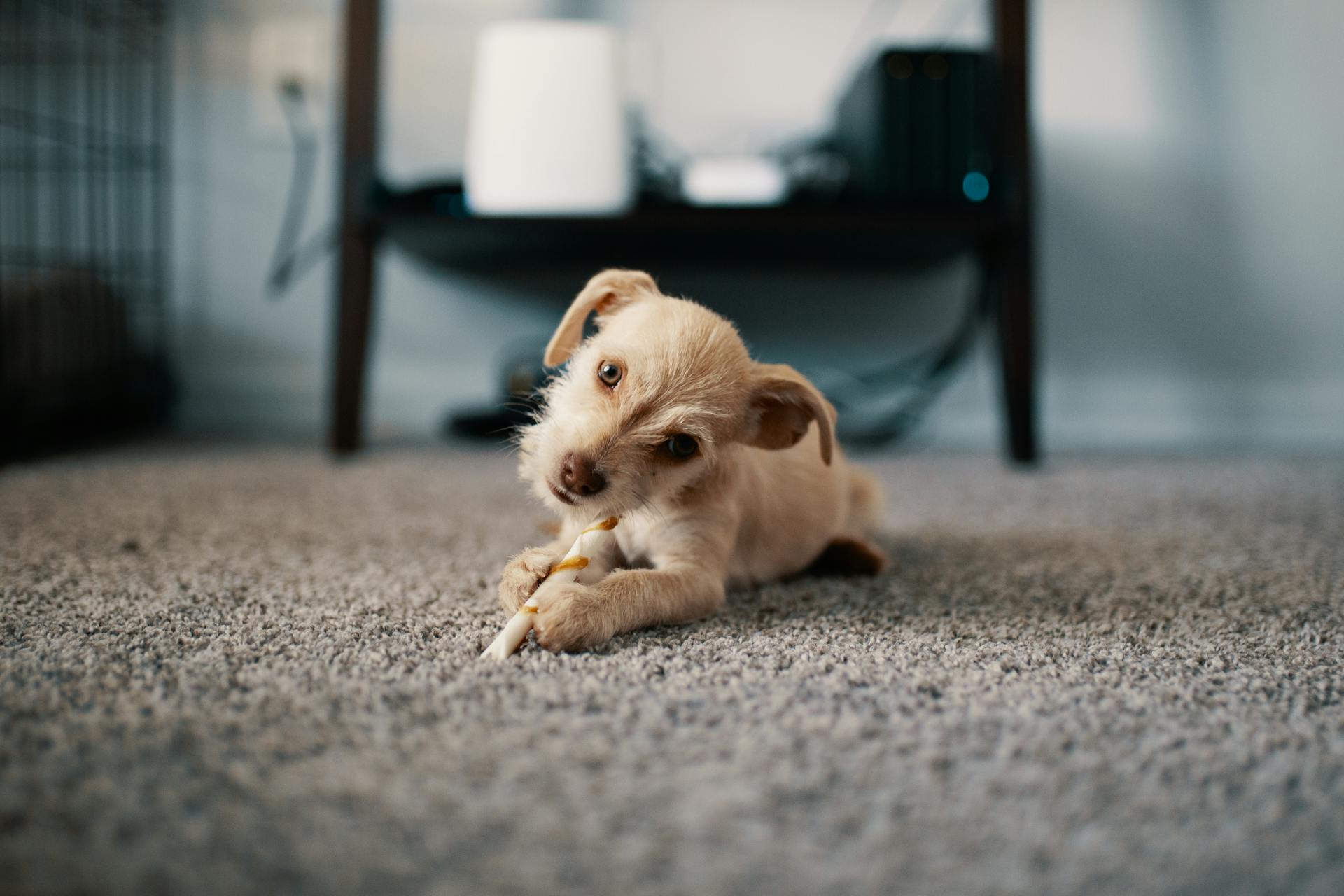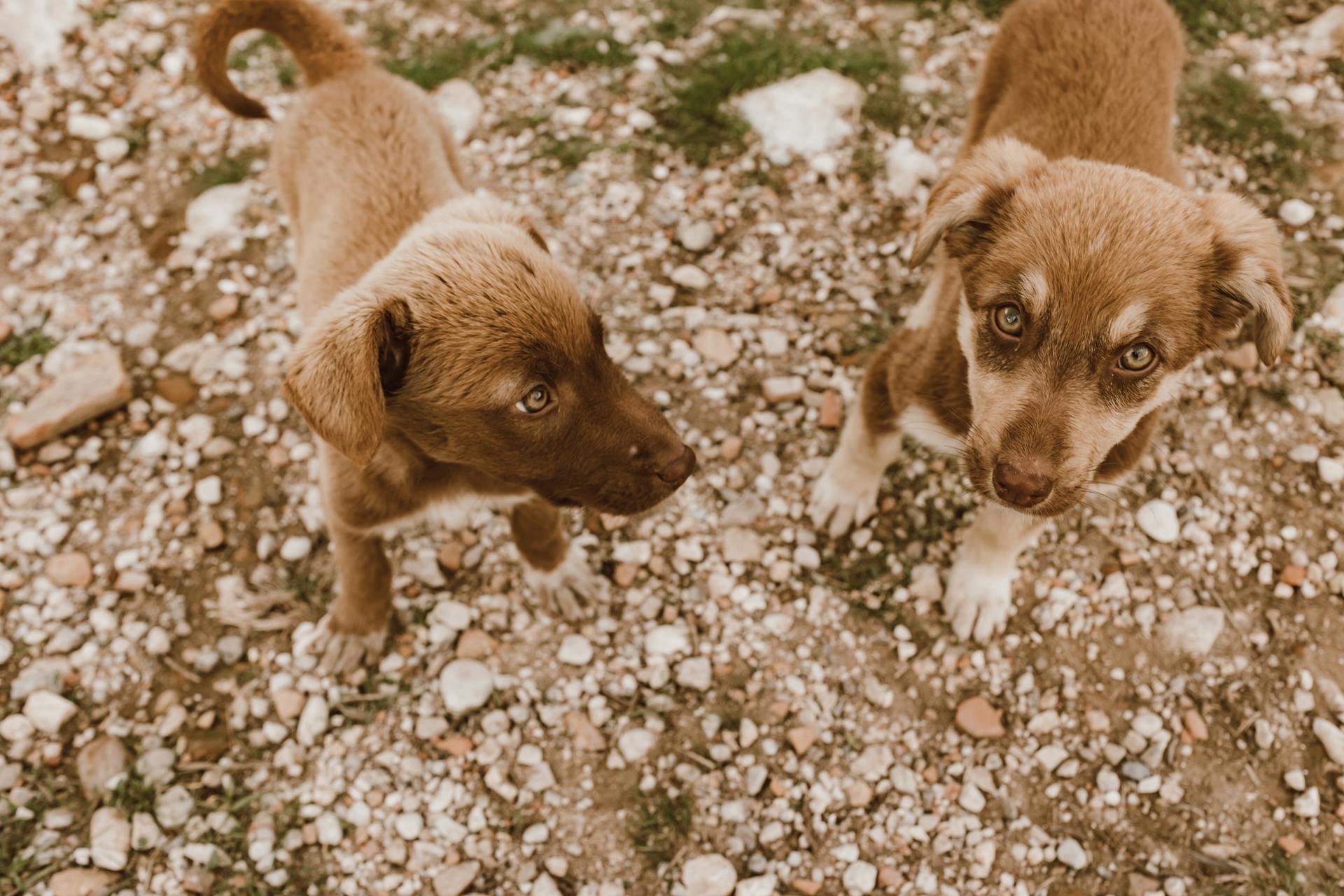
Training two puppies at once can be a daunting task, but with the right approach, it can be a rewarding experience for the whole family. Research shows that puppies learn best in short intervals of 5-10 minutes, so it's essential to keep training sessions brief.
Puppies have short attention spans, so it's crucial to make the most of the time you have. This means staying focused and avoiding distractions during training sessions.
It's also vital to establish a routine and stick to it, as puppies thrive on predictability. By creating a schedule for feeding, exercise, and playtime, you can help your puppies feel secure and develop good habits.
Puppies are social creatures and learn from each other, so training two puppies at once can be beneficial for their development.
Housebreaking Strategies
Consistency is key when it comes to housebreaking two puppies at once. Establishing a solid, predictable routine helps them understand what to expect and when.
Recommended read: When to Stop Crate Training
You need a system, and it's as simple as bookending every activity with a potty break. This means taking your puppies outside to eliminate after meals, naps, and playtime.
Having a designated area for potty breaks is also crucial. This can be a specific room or area in your home, such as a kitchen with tile flooring, that makes cleanup easy and allows for the use of puppy gates to keep them confined.
Crate training can help with communication and structure, especially for new puppies. Adding a cozy bed, an old t-shirt with your scent, and a blanket or crate cover can make the crate feel more secure and den-like.
Puppies thrive on routine, so establish regular feeding times, potty breaks, playtime, and rest. This will help them anticipate their needs and make potty training easier.
You can also use pee pads in a designated area, such as by the back door, to help your puppies learn to eliminate in a specific spot. Rewarding them with treats when they use the pee pads or go outside will encourage good behavior.
For another approach, see: Dog Training Pads
As your puppies get older and more reliable, you can gradually phase out the pee pads and have them use the bathroom outside instead. Just remember to give them plenty of praise and rewards for good behavior.
Creating a wind-down period before bedtime, such as 7-8 pm, can help your puppies learn to relax and eliminate before settling in for the night. This can be as simple as taking them outside for one last potty break and then covering their crates with blankets.
Understanding Puppy Behavior
Puppies have unique personalities, just like people, and some may be more bold and adventurous than others, while some might be more reserved and need extra time to grasp potty training.
Observing and adapting to these individual traits can significantly impact the effectiveness of your training approach. By tailoring your methods to each puppy's learning style, you can enhance their understanding and cooperation.
During the socialization stage, puppies become aware of their relationship with humans and learn how to react to things they encounter in their world. If you have two puppies, they might mutually agree on undesirable behaviors, such as chewing on shoes, without waiting for your response.
Common behaviors that can develop in puppies with littermate syndrome include separation anxiety, fear of new people or objects, and fear aggression. These behaviors can be addressed with expert guidance and patience.
Here are some common signs of littermate syndrome:
- Separation anxiety when away from the other puppy
- Fear of new people, animals, objects, or experiences
- Fear aggression, which can occur when a puppy encounters a new experience, feels threatened or scared, and reacts by barking, biting or trying to escape
- Reactivity when on a leash
- Fighting habits when they reach sexual maturity around 6 months of age
- Aggression or nervousness in the more dominant puppy; timidity and withdrawal in the less dominant puppy
Understand Individual Personalities
Puppies have unique personalities, just like people, and some may be bold and adventurous while others are more reserved.
Observing these individual traits can significantly impact the effectiveness of your training approach.
Some puppies may be quick to understand new concepts, while others may need additional time and patience to grasp potty training.
Tailoring your methods to each puppy's learning style can enhance their understanding and cooperation.
It's essential to be patient and adapt to each puppy's unique needs and personality.
Every puppy learns at its own pace, and it's crucial to be supportive and persistent throughout the process.
By understanding and respecting these individual differences, you can build a stronger bond with your puppy and make training a more enjoyable experience for both of you.
Recognizing Littermate Syndrome
Recognizing Littermate Syndrome is crucial to addressing potential behavioral issues in puppies. Littermate Syndrome occurs when puppies are too closely bonded, often because they're raised together, and they look to each other for guidance rather than their owner.
The socialization stage, between 3-12 weeks old, is when puppies become aware of their relationship with humans. Puppies learn to react to new stimuli during this stage, and if bonded closely with their owner, they look to their owner for praise or redirection.
If you have two puppies, they might mutually agree on undesirable behaviors, like chewing on shoes, without waiting for your response. This can lead to unhealthy behaviors and habits.
Puppies with Littermate Syndrome can develop separation anxiety when away from each other, fear of new people, animals, objects, or experiences, and fear aggression. They may also exhibit reactivity on a leash or develop fighting habits when they reach sexual maturity around 6 months of age.
Common behaviors associated with Littermate Syndrome include:
- Separation anxiety when away from the other puppy
- Fear of new people, animals, objects, or experiences
- Fear aggression
- Reactivity when on a leash
- Fighting habits when they reach sexual maturity
- Aggression or nervousness in the more dominant puppy; timidity and withdrawal in the less dominant puppy
Sources
- https://lindseyandcoco.com/blogs/news/the-down-dirty-of-housebreaking-littermates-how-to-potty-train-multiply-dogs-at-once
- https://www.alphapaws.com/how-to-potty-train-multiple-puppies-guide/
- https://www.fampetvet.com/services/dogs/blog/two-puppies-same-time
- https://today.tamu.edu/2023/09/28/understanding-littermate-syndrome-in-puppy-pairs/
- https://www.midwaydogacademynorthcarolina.com/getting-2-puppies-at-once-littermates/
Featured Images: pexels.com


